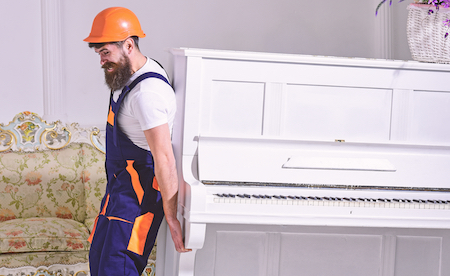You have a piano you need to move from here to there. Where do you start? What should you do?
Before you get a few friends together and throw it in the back of a truck, there are a few things to consider.
The Importance of Professional Piano Relocation
Moving a piano is no small feat; it requires careful planning, precision, and expertise. Pianos are not only heavy and cumbersome but also incredibly delicate instruments that can be easily damaged if not handled with care during relocation. This is why entrusting the task to professional piano relocation services is essential for preserving the integrity and value of your musical masterpiece.
Even the slightest misalignment or damage to these components can affect the instrument’s sound and performance. Unlike other pieces of furniture, pianos have unique characteristics that make them particularly challenging to move:
- Size and Weight – Pianos come in various shapes and sizes, from uprights to grands, and can weigh anywhere from a few hundred to over a thousand pounds. Their bulkiness and weight make them difficult to maneuver and require specialized equipment and techniques for safe transport.
- Fragility – Despite their solid appearance, pianos are surprisingly delicate. The internal mechanisms, such as the strings, hammers, and action, are susceptible to damage from impact, vibration, and changes in temperature or humidity. Even small bumps or jolts during transit can cause serious harm to the instrument.
- Balance and Stability – Pianos are meticulously designed to maintain balance and stability while producing sound. Any tilt or shift in position can throw off this delicate equilibrium, affecting the instrument’s tuning and performance. Proper handling and positioning are crucial to ensure the piano retains its structural integrity throughout the relocation process.
Risks of Amateur or DIY Relocation Methods
While it may be tempting to cut costs by attempting to move a piano on your own or with the help of inexperienced movers, doing so can lead to disastrous consequences. Amateur or DIY relocation methods pose several risks to both the piano and the individuals involved:
- Physical Injury – Pianos are heavy and awkward to lift, increasing the risk of strain, muscle sprains, and other injuries to those attempting to move them without proper training or equipment.
- Damage to the Piano – Without the necessary expertise and tools, amateurs may inadvertently scratch, dent, or even break parts of the piano during handling or transport. Additionally, improper packing or securing of the instrument can result in internal damage or misalignment.
- Property Damage – Maneuvering a piano through doorways, hallways, and staircases requires skill and precision to avoid damaging walls, floors, and other furniture. Amateur movers may cause costly repairs to the property in the process.
The Need for Expertise and Experience
Given the unique challenges involved in piano relocation, entrusting the task to professionals with specialized knowledge and experience is paramount. Professional piano movers undergo rigorous training and follow established protocols to ensure the safe and efficient transport of pianos:
- Specialized Equipment – Professional piano movers are equipped with specialized tools, such as piano dollies, straps, and padding, designed specifically for moving pianos safely and securely.
- Technical Know-How – Professional movers understand the intricate workings of pianos and know how to disassemble, pack, and reassemble them without causing damage. They also possess the skills to navigate tight spaces, stairs, and other obstacles with ease.
- Insurance Coverage – Reputable piano movers offer insurance coverage to protect against any unforeseen accidents or damages during transit. This provides peace of mind, knowing that your prized possession is in capable hands.
Where is your Relocation Taking You?
Are you off to a new home, a new city, a new town?
The expertise and precision of professional piano relocation services are indispensable for ensuring the safe and seamless transport of your musical masterpiece. By entrusting the task to professionals, you can rest assured that your piano will arrive at its destination unscathed and ready to fill your home with beautiful music.
Let’s get started now.











